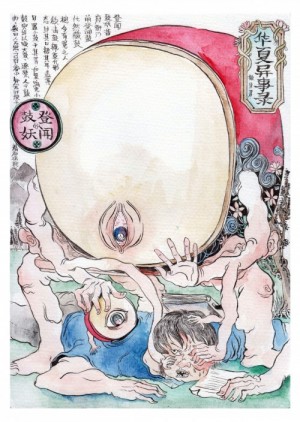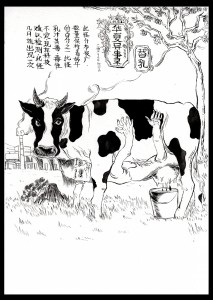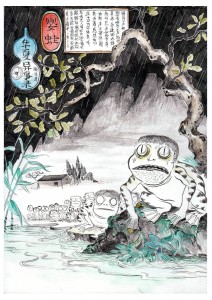Satan Lucky is the pen name of cartoonist and illustrator based in Beijing. He publishes some of his work on Weibo. His style is based on Ukiyo-e — literally “pictures of the floating world”, the traditional Japanese style of woodblock prints and paintings of nature, history, scenes from the theater and of geishas and other urban decadences.
Some of Satan Lucky’s cartoons depict fantastic beats that seem to have no connection with contemporary reality, while others can be read as critical commentary In the gallery below, for example, 404 (the error number most Web browsers indicate when trying to access a blocked site in China) is depicted as a beast that sits on the computer, blocking access to Youtube and Facebook, while Flesh Net Beggar refers to the way in which resourceful people can avoid paying fines to the Flesh Net Beggar and “jump over” the Great Firewall.
- 404
- Throwing Pigs
- Red Bean Mermaid
In Red Bean Mermaid, a mermaid tempts men into the red-dyed river outside a chemical factory into the water, and Throwing Pigs is a reference to the 6,000 plus dead pigs that floated down Shanghai’s Huangpu river in March this year. The Crooked Heart Mirror ”cannot be seen with human eyes but accompanies people wherever they go,” according to Satan, is an allusion to the different values on either side of China’s generation gap (代沟) and the problems that this phenomenon has created. Meanwhile, the Baby-Frog, with its terrible wail, is a comment on the forced abortions and infanticide that have tarnished China’s one-child policy. The Ti Ru Cow (or substitute milk cow) produces poisonous milk. Masses Fight the Ox alludes to the public frustration with huangniu (literally “ox”, but actually refers to ticket scalpers) who monopolise the supply of tickets for everything from train journeys to football matches.Tendon-pulling macaque refers to the problem of shoddy building standards hidden behind the gleaming façades of some of China’s new constructions. Stories in the Kiln features the ghosts of miners who died in a mining disaster, who require nothing more than an audience to be reincarnated.
Danwei asked Satan Lucky a few questions about his life and work and we present the answers together with some of his works, published here with his permission. A further selection of his work can be viewed here.
- The Tendon-Pulling Macaque
- The Masses Fight the Ox
- Flesh Net Beggar
- Stones in the Kilm
- Ti Ru Cow
- Crooked Mirror
- Baby-Frog
- Fox Scarf
- Net-Cutting Roe
When did you start drawing cartoons, and when did you incorporate social and political themes into your work? Have there been any particular turning points in your career?
I first studied drawing when I was a teenager, but it was not until I was in university that I actually started doing anything creative. Even then, it was still not until I had gotten a job that I began to draw cartoons involving social and political themes. As for any turning points, it’s not quite like that. When you think for yourself, you want to express something with a link to the time that you are living in.
Why have you chosen to paint in a Japanese style?
I’m a member of the post-80s generation, so I grew up watching Japanese cartoons. Ukiyo-e has had a real effect on me. Naturally, this has had a considerable impact on my work. Still, I’ve also been inspired by Chinese styles, such as Jiezieyuan (芥子园). My work is not just affected by Japanese drawing. (editor’s note: Gaiziyuan, translated as “Manual of the Mustard Seed Garden,” is the famous early Qing painting manual which served as a guide to many late Imperial and early Republican painters, among them Qi Baishi.)
Why did you choose the name ‘Satan’?
I didn’t put a whole lot of thought into it. I was bit of a fool when I was younger, and I thought it was a very cool name. But now I can’t be bothered to change it because people I know from art circles recognize me by it. Anyway, in the end it’s just a nickname.
You have said that “cartoons and writing are both forms of expression”. What do you think are the similarities and differences between them?
From my perspective, they are of equal standing as tools for expression. But for the public, they are not quite on par with each other.
Why does so much of your work focus on ghosts and goblins? Is it because you want to use them as analogies for what you really want to describe?
I can’t say for certain. Ghosts are evocative of strange goings-on. Indeed, this is why people from ancient times created the concept of ghosts in the first place. But I don’t draw in order to explain things of the ordinary and unknown. I just draw these cartoons to keep carrying on with my passion.
There are so many political cartoonists who are active on Weibo, how do you feel about this situation?
It’s great that there are so many cartoonists. They use their own pen to express their ideas – what’s bad about that? Drawing political cartoons is first and foremost a mode of employment. I don’t have a particularly strong opinion about that. Each one of them is brightening up social media.
Is cartoon-drawing your principal source of income?
I make most of my money through my cartoons, but I don’t have a contract – I work as a freelancer.













